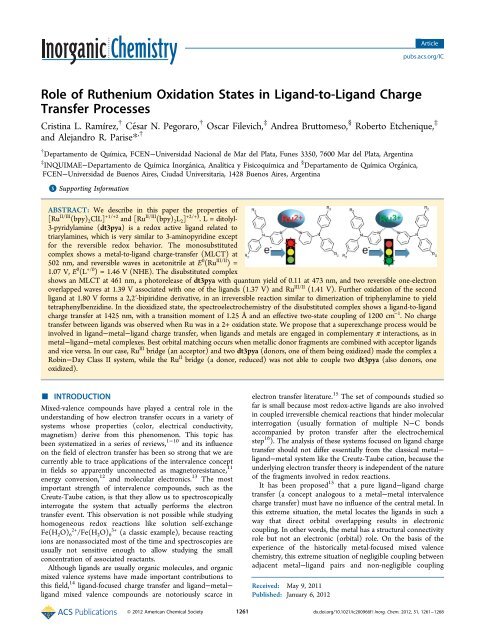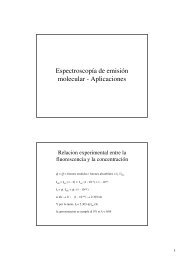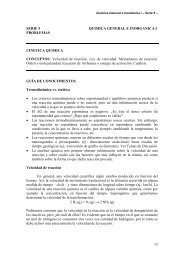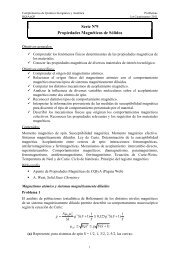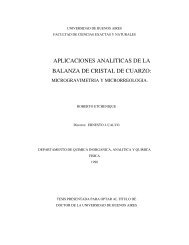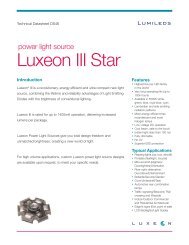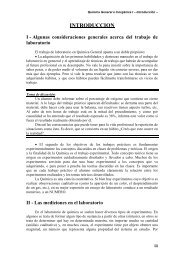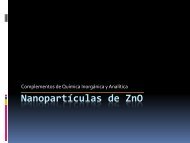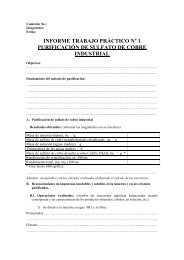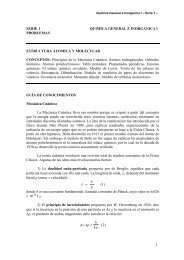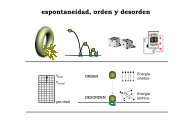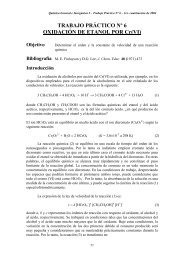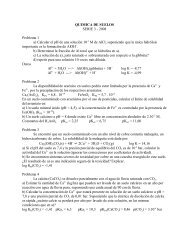Role of Ruthenium Oxidation States in Ligand-to-Ligand Charge ...
Role of Ruthenium Oxidation States in Ligand-to-Ligand Charge ...
Role of Ruthenium Oxidation States in Ligand-to-Ligand Charge ...
Create successful ePaper yourself
Turn your PDF publications into a flip-book with our unique Google optimized e-Paper software.
Inorganic Chemistrybetween remote metals seems <strong>to</strong> be rather the exception thanthe rule. Even <strong>in</strong> metal localized mixed-valence compounds like[Ru(NH 3 ) 5 -4,4′-bipyrid<strong>in</strong>e-Ru(NH 3 ) 5 ] 5+ there is always somek<strong>in</strong>d <strong>of</strong> <strong>in</strong>teraction with the bridge, reflected <strong>in</strong> the appearance<strong>of</strong> a metal-<strong>to</strong>-ligand charge-transfer (MLCT) beside a metal-<strong>to</strong>metalcharge transfer (MMCT). In these cases, the <strong>in</strong>teractionsbetween adjacent sites are responsible for an electron transferprocess <strong>in</strong>volv<strong>in</strong>g remote metals, without a direct metal−metalcoupl<strong>in</strong>g (a superexchange bridge-mediated mechanism).Here, we will describe the mono and dicoord<strong>in</strong>ation <strong>of</strong>di<strong>to</strong>lyl-3-pyridylam<strong>in</strong>e, which is a redox-active arylam<strong>in</strong>ederivative, <strong>in</strong><strong>to</strong> the fragment [Ru III/II (bpy) 2 ] 3+/2+ (bpy is 2,2′-bipyrid<strong>in</strong>e). The family <strong>of</strong> coord<strong>in</strong>ation compounds derivedfrom [Ru II (bpy) 3 ] 2+ has been widely studied for theirpho<strong>to</strong>chemical properties, especially the charge transfercapability from the excited electronic states. 17 Because <strong>of</strong> thischaracteristic, the chemistry <strong>of</strong> these compounds has shown <strong>to</strong>be attractive because <strong>of</strong> its potential application <strong>in</strong> systems forturn<strong>in</strong>g visible radiation <strong>in</strong><strong>to</strong> chemical energy, 18,19 a <strong>to</strong>pic thathas become a priority because <strong>of</strong> the new social valuesregard<strong>in</strong>g the use <strong>of</strong> natural resources. In this direction, the use<strong>of</strong> the fragment [Ru II (bpy)(SCN) 2 ] 0 with bidentate ligandsderived from triarylam<strong>in</strong>es (redox-active) that allows a fast <strong>in</strong>situ regeneration <strong>of</strong> the Ru III fragment formed after charge<strong>in</strong>jection <strong>in</strong><strong>to</strong> the support<strong>in</strong>g semiconduc<strong>to</strong>r has been recentlyreported. 20 Triarylam<strong>in</strong>es are a family <strong>of</strong> compounds which hasreceived considerable attention <strong>in</strong> recent years as hole transportmaterials, because <strong>of</strong> their chemical robustness and versatility <strong>in</strong>derivatization for controll<strong>in</strong>g their redox potential. 21 S<strong>in</strong>ce theirE 0 is close <strong>to</strong> that <strong>of</strong> the [Ru III/II (bpy) x ] +3/+2 series, thesefragments are <strong>in</strong>terest<strong>in</strong>g <strong>to</strong> be <strong>in</strong>corporated <strong>in</strong> redoxop<strong>to</strong>electronic devices for electrical conduction.■ EXPERIMENTAL SECTIONReagents and solvents were purchased from Sigma-Aldrich, Anedra,Dorwill, and Cicarelli. Solvents were purified as described elsewhere. 22[Ru(bpy) 2 Cl 2 ] 0 and [Ru(bpy) 2 (3-am<strong>in</strong>opyrid<strong>in</strong>e) 2 ](PF 6 ) 2 were synthesizedas previously described. 23,24 Electrochemical experimentswere measured <strong>in</strong> an anaerobic three-electrode cell with a silver wire asa pseudoreference, a 50 μ plat<strong>in</strong>um disk as work<strong>in</strong>g electrode, and aplat<strong>in</strong>um wire as a counterelectrode. Redox potentials were reportedaga<strong>in</strong>st NHE (ferrocene was added as <strong>in</strong>ternal standard aftermeasurements 25 ). Spectroelectrochemistry experiments were performedwith a four-electrode quartz th<strong>in</strong> layer cell us<strong>in</strong>g a graphitefelt counterelectrode, plat<strong>in</strong>um woven wire work<strong>in</strong>g electrode (70 μwires), a silver pseudoreference and an additional small plat<strong>in</strong>umelectrode <strong>to</strong> measure cyclic voltammograms prior <strong>to</strong> the electrolysis.Electronic spectra were measured <strong>in</strong> a Shimadzu spectropho<strong>to</strong>meterUV-3101PC, electrochemistry experiments with a potentiostat TEQ-3,NMR spectra <strong>in</strong> a Bruker AM-500, and high resolution mass spectra <strong>in</strong>a Bruker micrOTOF-QII.The setup <strong>to</strong> measure the pho<strong>to</strong>lysis quantum efficiencies consisted<strong>of</strong> three coll<strong>in</strong>early aligned lasers at 532 nm, 473 nm, and 405 nmrespectively. An Ocean Optics PC2000 diode-array spectropho<strong>to</strong>meterwas mounted normally <strong>to</strong> the laser light path as <strong>in</strong> a fluorescencesetup. A quartz cuvette was at the center <strong>of</strong> the arrangement <strong>in</strong> analum<strong>in</strong>um holder. This was thermostatized with a peltier element, anLM35 temperature sensor, and cus<strong>to</strong>m feedback electronics. Amagnetic stirrer provided solution homogeneity. Laser power wasmeasured by directly hitt<strong>in</strong>g a light power meter and found <strong>to</strong> beconstant throughout the experiments for all three lasers. Full spectrawere acquired every 2 s with OOIChem s<strong>of</strong>tware. Data fitt<strong>in</strong>g werecarried out <strong>of</strong>fl<strong>in</strong>e by numerical <strong>in</strong>tegration <strong>of</strong> the follow<strong>in</strong>gexpression:1262−Absd n /d t = I (1 − 10 Tp beam)Abs R/AbsTφArticlewhere n p are the moles <strong>of</strong> released ligand, I beam is the <strong>in</strong>tensity <strong>of</strong> the<strong>in</strong>cident light <strong>in</strong> E<strong>in</strong>ste<strong>in</strong>s/s, Abs T is the <strong>to</strong>tal absorbance <strong>of</strong> thesolution at the beam’s wavelength, Abs R is the absorbance <strong>of</strong> Ru-(dt3pya) 2 complex (see below) at the same wavelength, and Φ is thepho<strong>to</strong>labilization quantum yield.Fac<strong>to</strong>r analysis <strong>of</strong> the spectroelectrochemistry experiment was madeas reported 26 us<strong>in</strong>g a two successive redox steps (C + 1 e − → B, B + 1e − → A each one with a different value <strong>of</strong> E 0 , with the analyticalconcentration <strong>of</strong> the <strong>in</strong>itial sample) as fitt<strong>in</strong>g model.Di<strong>to</strong>lyl-3-pyridylam<strong>in</strong>e (dt3pya). One gram (5 mmol) <strong>of</strong>di<strong>to</strong>lylam<strong>in</strong>e, 1.04 g (5 mmol) <strong>of</strong> 3-iodopyrid<strong>in</strong>e, 0.8 g (7 mmol) <strong>of</strong>potassium tert-bu<strong>to</strong>xide, and 40 mg <strong>of</strong> a mixture <strong>of</strong> ratio 1:1 <strong>of</strong> CuI and1−10 phenanthrol<strong>in</strong>e were dissolved <strong>in</strong> 10 mL <strong>of</strong> dry <strong>to</strong>luene. Themixture was heated over 12 h, reflux<strong>in</strong>g at 110−115 °C, cooled, andthen filtered <strong>to</strong> elim<strong>in</strong>ate <strong>in</strong>soluble particles. The filtrate was adsorbedon silica Merck 60 and eluted us<strong>in</strong>g a solvent gradient (100%dichloromethane, dichloromethane ethyl acetate 98%/2%) <strong>in</strong> a 3 × 10cm column. Yield: 0.9 g (65%). NMR 1 H (500 MHz, see Figure 1 forFigure 1. <strong>Ligand</strong> (di<strong>to</strong>lyl-3-pyridylam<strong>in</strong>e, dt3pya) used <strong>in</strong> this study.Numeration relates <strong>to</strong> 1 H NMR characterization (see ExperimentalSection).a<strong>to</strong>m number<strong>in</strong>g): δ = 8.13 (H-2, bd, J = 3.8 Hz, 1H), 7.09 (H-4, m,1H), 7.29 (H-5, ddd, J = 1.4, 2.9, 8.4 Hz, 1H), 8.32 (H-6, bs, 1H), 6.98(H-8, d, J = 8.2 Hz, 4H), 7.08 (H-9, d, J = 8.2 Hz, 4H), 2.34 (H-11, s,6H). NMR 13C: δ = 142.0, 144.7, 123.5, 128.3, 144.3, 124.7, 130.2,133.5, 20.8.[Ru(bpy) 2 Cl-dt3pya] (PF 6 ) (Ru-dt3pya). A 100 mg portion <strong>of</strong>[Ru(bpy) 2 Cl 2 ] (0.2 mmol) was suspended <strong>in</strong> 5 mL <strong>of</strong> 96% ethanoland 2 mL <strong>of</strong> water under argon atmosphere. Then, 55 mg <strong>of</strong> dt3pya(0.2 mmol) and 200 mg <strong>of</strong> LiCl were added. The mixture wasprotected from light and heated <strong>to</strong> 90 °C until the spectrum rema<strong>in</strong>edunchanged. The solution was evaporated <strong>in</strong> darkness, redissolved <strong>in</strong>water and precipitated by add<strong>in</strong>g drops <strong>of</strong> saturated NH 4 PF 6 solution<strong>in</strong> water. The solid was filtered, redissolved <strong>in</strong> 3 mL <strong>of</strong> LiCl saturatedace<strong>to</strong>ne and refluxed over 1 h. This solution was dropped <strong>in</strong><strong>to</strong> water(with cont<strong>in</strong>uous stirr<strong>in</strong>g), render<strong>in</strong>g a red precipitate which wasfiltered and washed several times with cold water. This procedure forseparation and s<strong>to</strong>rage had <strong>to</strong> be carried out <strong>in</strong> darkness because <strong>of</strong> thepho<strong>to</strong>lability <strong>of</strong> dt3pya. Yield: 120 mg (70%). 1H NMR (500 MHz,ace<strong>to</strong>ne-d6): δ = 2.33 (s, 6H), 6.78 (d, J = 7.6 Hz, 4H), 7.00 (d, J = 7.7Hz, 2H), 7.04 (d, J = 7.6 Hz, 4H), 7.05 (d, J = 8.4 Hz, 1H), 7.11 (d, J= 7.8 Hz, 1H), 7.22 (d, J = 8.7 Hz, 1H), 7.27 (s, 1H), 7.46 (d, J = 5.6Hz, 1H), 7.51 (d, J = 4.2 Hz, 1H), 7.58 (m, 2H), 7.63 (q, J = 8.4, 8.4,8.4 Hz, 2H), 8.06 (t, J = 7.8, 7.8 Hz, 1H), 8.00 (t, J = 7.8, 7.8 Hz, 1H),8.11 (d, J = 8.0 Hz, 1H), 8.16 (d, J = 8.1 Hz, 1H), 8.33 (dd, J = 7.9, 2.4Hz, 2H), 8.59 (d, J = 5.4 Hz, 1H), 9.85 (d, J = 4.9 Hz, 1H). ESI-MS:m/z calcd for C 39 H 34 ClN 6 Ru ([Ru(bpy) 2 ClL] 1+ ): 723.1577; found:723.1578.[Ru(bpy) 2 (dt3pya) 2 ](PF 6 ) 2 (Ru-(dt3pya) 2 ). A 100 mg portion <strong>of</strong>[Ru(bpy) 2 Cl 2 ] (0.2 mmol) was suspended <strong>in</strong> 6 mL <strong>of</strong> water andheated <strong>to</strong> 90 °C under argon atmosphere. Labilization <strong>of</strong> Cl − <strong>to</strong> form[Ru II (bpy) 2 (H 2 O) 2 ] 2+ (λ max = 480 nm) was completed after 1 h. Then,110 mg (0.4 mmol) <strong>of</strong> dt3pya dissolved <strong>in</strong> 1.5 mL <strong>of</strong> 96% ethanol wasadded. The result<strong>in</strong>g suspension was heated with stirr<strong>in</strong>g at 90 °C for12 h <strong>in</strong> darkness, and kept <strong>in</strong> an argon atmosphere until fulldisplacement <strong>of</strong> water by dt3pya. The orange solution was filtered <strong>to</strong>dx.doi.org/10.1021/ic200966f | Inorg. Chem. 2012, 51, 1261−1268
Inorganic ChemistryArticleTable 1. MLCT Maxima, Redox Potential and Pho<strong>to</strong>labilization Quantum Yield for cis-[Ru II (bpy) 2 XY] ComplexesX−Y ligand λ MLCT (nm) Ru III/II (V) a L 1 +/0 (V) a L 2 +/0 (V) a Φ bCl 2 553, 380 c 0.53 cCl− L 502 d 1.07 d 1.46 dL 2 461 d 1.39 d (1.37 e ) 1.39 d (1.41 e ) 1.80 d 0.11 df(3ampy) 2 463 g 1.42 g 0.08 da In ace<strong>to</strong>nitrile. b In ace<strong>to</strong>ne. c Ref 26. d This paper. e From fac<strong>to</strong>r analysis. f 3-ampy is 3 am<strong>in</strong>opyrid<strong>in</strong>e. g Ref 24.remove <strong>in</strong>soluble materials, and the filtrate was precipitated by add<strong>in</strong>gdrops <strong>of</strong> saturated NH 4 PF 6 solution. The suspension was filtered (orcentrifuged) and washed several times with cold water. The procedurefor separation and s<strong>to</strong>rage had <strong>to</strong> be carried out <strong>in</strong> the dark because <strong>of</strong>the pho<strong>to</strong>lability <strong>of</strong> dt3pya. Yield: 200 mg (80%). 1 H NMR (500MHz, ace<strong>to</strong>ne-d6) δ = 2,34 (s, 12H), 6.94 (m, 8H), 7.21 (m, 10H),7.31 (m, 2H), 7.38 (dd, J = 8.6, 2.5 Hz, 2H), 7.68 (d, J = 2.5 Hz, 2H),7.78 (d, J = 5.0, 2H), 7.98 (d, J = 5.0, 2H), 7.98 (td, J = 6.8, 1.4 Hz,2H), 8.05 (td, J = 8.0, 1.4 Hz, 2H), 8.34 (td, J = 8.0, 1.4 Hz, 2H), 8.58(d, J = 8.0 Hz, 2H), 8.69 (d, J = 8.0 Hz, 2H), 8.89 (d, J = 5.0 Hz, 2H).ESI-MS: m/z calcd for C 58 H 52 N 8 Ru ([Ru(bpy) 2 L 2 ] 2+ ): 481.1679;found: 481.1666.■ RESULTS AND DISCUSSIONFigure 1 shows the ligand dt3pya (di<strong>to</strong>lyl-3-pyridylam<strong>in</strong>e) used<strong>in</strong> this study. The 1 H NMR spectrum <strong>of</strong> Ru-dt3pya showed acomplex set <strong>of</strong> signals (34 pro<strong>to</strong>ns <strong>in</strong> 19 signals), reflect<strong>in</strong>g theasymmetry <strong>of</strong> substitution at the cis positions (Cl − and dt3pya).In contrast, the spectrum <strong>of</strong> Ru-(dt3pya) 2 showed 52 pro<strong>to</strong>ns<strong>in</strong> only 14 signals, correspond<strong>in</strong>g <strong>to</strong> a more symmetricalcompound. This is consistent with the rotation <strong>of</strong> coord<strong>in</strong>ateddt3pya which, for NMR spectroscopy time scales, dynamicallyaverages the field seen by other pro<strong>to</strong>ns and presents both cissubstitution sites as <strong>in</strong>dist<strong>in</strong>guishable. A similar effect wasalready observed <strong>in</strong> mono and disubstituted analogues with 4-am<strong>in</strong>opyrid<strong>in</strong>e. 27 A prelim<strong>in</strong>ary observation <strong>of</strong> possiblecoord<strong>in</strong>ated dt3pya movements <strong>in</strong> Ru-(dt3pya) 28 2 shows thatthe rotation <strong>of</strong> the ligand is possible, but needs <strong>to</strong> be concertedwith the other ligand <strong>to</strong> generate enough space <strong>to</strong> allow fullmovement (especially regard<strong>in</strong>g the <strong>in</strong>dependent rotation <strong>of</strong>the pyrid<strong>in</strong>e). 29Table 1 shows a comparison <strong>of</strong> basic <strong>in</strong>formation between[Ru(bpy) 2 Cl 2 ], Ru-dt3pya, and Ru-(dt3pya) 2 <strong>in</strong> terms <strong>of</strong>MLCT (ace<strong>to</strong>nitrile), pho<strong>to</strong>labilization quantum yield (ace<strong>to</strong>ne),and redox potential (ace<strong>to</strong>nitrile), <strong>to</strong>gether with[Ru(bpy) 2 (3-am<strong>in</strong>opyrid<strong>in</strong>e) 2 ] 2+ . Electronic spectroscopyshowed that MLCT Ru II → bpy* charge transfer shifted <strong>to</strong>higher energies as Cl − was replaced by dt3pya (553, 502, and461 nm for Cl 2 , Cl-dt3pya, and dt3pya 2 , respectively). This is acommon motif for accep<strong>to</strong>r ligands because <strong>of</strong> the stabilization<strong>of</strong> Ru II t 2g orbitals after mix<strong>in</strong>g with π* <strong>of</strong> the ligand, 30 and it isalso reflected <strong>in</strong> a redox potential shift <strong>to</strong> oxidant values (0.53,1.07, 1.41 V for the same complexes). Comparsion <strong>of</strong> Ru-(dt3pya) 2 with [Ru(bpy) 2 (3-am<strong>in</strong>opyrid<strong>in</strong>e) 2 ] 2+ reveals a verysimilar MLCT (461 nm vs 463 nm), E 0 (1.41 V vs 1.42 V, seebellow), and pho<strong>to</strong>labilization quantum yield (0.11 vs 0.08, seebellow) that suggests conjugation with phenyls has little effec<strong>to</strong>n the π donor and π accep<strong>to</strong>r capabilities <strong>of</strong> dt3pya comparedwith unsubstituted 3-am<strong>in</strong>opyrid<strong>in</strong>e.The chemistry <strong>of</strong> [Ru II (bpy) 2 L 2 ] 2+ (L = aliphatic or aromaticam<strong>in</strong>e) is characterized by the pho<strong>to</strong>labilization <strong>of</strong> ligand L, 31which is responsible for the need <strong>to</strong> avoid light dur<strong>in</strong>g thesynthesis <strong>of</strong> these compounds. This property has made thempromis<strong>in</strong>g as scheduled-delivery neurotransmitter agents <strong>in</strong>liv<strong>in</strong>g tissues, with verified physiological activity only whenillum<strong>in</strong>ated. 27 Consistently with this behavior, the NMRspectrum <strong>of</strong> irradiated solutions <strong>of</strong> Ru-(dt3pya) 2 showed theappearance <strong>of</strong> the methyl signals <strong>of</strong> the free ligand dt3pya at2.31 ppm, as well as a decrease <strong>in</strong> the <strong>in</strong>tegration <strong>of</strong> thecoord<strong>in</strong>ated ligand at 2.34 ppm (Support<strong>in</strong>g Information S1).Changes <strong>in</strong> the UV−vis spectrum <strong>of</strong> the solution dur<strong>in</strong>girradiation are shown <strong>in</strong> Figure 2, from which we fit a value <strong>of</strong> ϕ= 0.11 (quantum yield) for dt3pya release <strong>in</strong> Ru-(dt3pya) 2 .Figure 2. UV−vis spectra <strong>of</strong> Ru-(dt3pya) 2 <strong>in</strong> ace<strong>to</strong>ne dur<strong>in</strong>girradiation at 473 nm. Inset: moles <strong>of</strong> released ligand vs time.The quantum efficiencies for labilization depend on thestationary population <strong>of</strong> the e g dissociative state dur<strong>in</strong>g the deexcitationpathway follow<strong>in</strong>g irradiation. This state <strong>in</strong>creases itsparticipation <strong>in</strong> the decay mechanism as the π accep<strong>to</strong>r ability<strong>of</strong> ligands moves the MLCT state (and the triplet emitter state)above e g . 31 In practice, this means that π accep<strong>to</strong>r ligands(which blue-shift the energy <strong>of</strong> the MLCT Ru II → bpy*)propitiate pho<strong>to</strong>labilization. By contrast, π donor ligands (CN − ,SCN − , for example) <strong>in</strong>crease the e g state energy above thetriplet emitter state, which makes these complexes substitutionallypho<strong>to</strong><strong>in</strong>ert, suitable for practical uses <strong>in</strong> charge transferdevices. An example <strong>of</strong> this is the reported electron <strong>in</strong>jection<strong>in</strong><strong>to</strong> TiO 2 from the bpy centered excited state <strong>of</strong> the[Ru II (bpy)(SCN) 2 ] 0 fragment. 20 In this system, the rutheniumcenter is bound <strong>to</strong> an arylam<strong>in</strong>e-like ligand that plays the role <strong>of</strong>a temporary sacrificial electron-donat<strong>in</strong>g reagent. The technologicaluses <strong>of</strong> this k<strong>in</strong>d <strong>of</strong> compounds <strong>in</strong>volve achiev<strong>in</strong>g adevice with components <strong>in</strong> a spatial organization (usually layers<strong>in</strong> a high surface electrode) so that the movement <strong>of</strong> electronsgenerated from light absorption has a def<strong>in</strong>ed direction andsense.The cyclic (CV) and square wave (SWV) voltammograms <strong>of</strong>Ru-dt3pya <strong>in</strong> Figures 3a−b show two peaks associated <strong>to</strong> bpycoligands reduction at −1.19 V and −1.42 V. At oxidiz<strong>in</strong>gpotentials Ru-dt3pya showed two <strong>in</strong>dependent one-electronredox waves at 1.07 and 1.46 V (same current as reductionwaves). S<strong>in</strong>ce the spectroelectrochemistry <strong>of</strong> Ru-dt3pya at1263dx.doi.org/10.1021/ic200966f | Inorg. Chem. 2012, 51, 1261−1268
Inorganic ChemistryFigure 3. Voltammograms <strong>of</strong> Ru-dt3pya <strong>in</strong> ace<strong>to</strong>nitrile 0.1 MTBAPF 6 : (a) CV (100 mV/s), (b) SWV (25 Hz, 2 mV/step).Figure 4 showed that a decay <strong>of</strong> the MLCT Ru II → bpy isassociated with the first wave at 1.07 V, we assigned this processFigure 4. Spectroelectrochemistry <strong>of</strong> Ru-dt3pya <strong>in</strong> ace<strong>to</strong>nitrile, 0.1 MTBAPF 6 , from 0.9 <strong>to</strong> 1.7 V.<strong>to</strong> a Ru II oxidation. The later appearance <strong>of</strong> a band at 720 nm,similar <strong>to</strong> that <strong>of</strong> radicals derived from tri<strong>to</strong>lylam<strong>in</strong>e, 32 suggests(consistently) that the second redox process at 1.46 Vcorresponds <strong>to</strong> the oxidation <strong>of</strong> a redox-active ligand dt3pya.The voltammograms <strong>of</strong> Ru-(dt3pya) 2 <strong>in</strong> Figure 5a−bshowed two bpy reductions at −1.06 V and −1.25 V. Thehigher reduction potential compared <strong>to</strong> Ru-dt3pya reflects theeffect that metal electron density is shared with a moreextended π system (two dt3pya for backbond<strong>in</strong>g, <strong>in</strong>stead <strong>of</strong>one) and then bpy coligands are slightly less electron rich. Asimilar shift has been observed for a series <strong>of</strong> reportedcomplexes, 33 although with lower sensitivity. 34 Second, twoArticlewaves were found at oxidant potentials. One appears at 1.39 V,and it shows <strong>in</strong> the CV a current peak twice the <strong>in</strong>tensity thaneach bpy monoelectronic reduction. S<strong>in</strong>ce the diffusioncoefficient for the <strong>in</strong>itial specie <strong>in</strong> the voltammogram is thesame for both current waves (reduction and oxidation), we<strong>in</strong>fer that the wave at 1.39 V <strong>in</strong>volves two electrons. The secondwave <strong>in</strong> Ru-(dt3pya) 2 appears at 1.80 V and was notreversible. 35S<strong>in</strong>ce we have three redox centers <strong>in</strong> this complex and thewave at 1.39 V seems <strong>to</strong> be a bielectronic one, we need <strong>to</strong>assign which <strong>of</strong> the redox centers were first oxidized <strong>to</strong>understand the <strong>in</strong>tervalence properties that we will see below.Only two scenarios are expected for the dioxidized specie: <strong>in</strong>scenario “a” one ligand and the metal are oxidized, <strong>in</strong> scenario“b” both ligands are oxidized.Support<strong>in</strong>g scenario “a”, from Table 1 we see that dt3pyaoxidation <strong>in</strong> Ru-dt3pya appears at 1.46 V and Ru oxidation <strong>in</strong>[Ru(bpy) 2 (3ampy) 2 ] 2+ appears at 1.42 V, both values very close<strong>to</strong> the two electron wave at 1.39 V. This comparison suggeststhat one ligand and the ruthenium center would be the firs<strong>to</strong>xidized fragments.On the other hand, it is established that the contributions <strong>of</strong>the ligands <strong>to</strong> the redox potential <strong>of</strong> Ru III/II center can befac<strong>to</strong>red <strong>in</strong><strong>to</strong> σ and π <strong>in</strong>teractions with the metal, and areapproximately additive. 36 This is verified, for example, <strong>in</strong>successive replacements <strong>of</strong> Cl − by pyrid<strong>in</strong>e 31 <strong>in</strong> the follow<strong>in</strong>gseries: [Ru(bpy) 2 Cl 2 ] (0.53 V), [Ru (bpy) 2 ClPy] + (1.02 V),and [Ru(bpy) 2 (Py) 2 ] 2+ (1.53 V). S<strong>in</strong>ce the redox potential shiftbetween [Ru(bpy) 2 Cl 2 ] 0 and Ru-dt3pya was ≈0.5 V, weestimate that the result<strong>in</strong>g shift when replac<strong>in</strong>g both Cl − ligandsby two dt3pya should locate the redox couple Ru III/II at about1.61 V, which falls halfway between the first oxidation wave at1.39 V and the second one at 1.80 V. This estimation isconsistent with the simultaneous oxidation <strong>of</strong> both dt3pya(scenario “b”) at 1.39 V and the Ru oxidation at a potentialhigher than 1.61 V (1.80 V), because it would be coord<strong>in</strong>ated<strong>to</strong> two positive (then, more accep<strong>to</strong>r after oxidation) ligands.Next, we look at the spectroscopic <strong>in</strong>formation.Figure 6a−b shows four spectra <strong>of</strong> the spectroelectrochemistryexperiment <strong>of</strong> Ru-(dt3pya) 2 <strong>in</strong>side the 1.39 V redox waveand the absorbance changes at 712 y 1425 nm. It is clear thatthe first spectral change <strong>in</strong> this wave (spectrum b) is theappearance <strong>of</strong> a band at 712 nm without any absorption <strong>in</strong> theNIR. 37 This band is characteristic <strong>of</strong> triarylam<strong>in</strong>e radicals,similar <strong>to</strong> the one found at 720 nm <strong>in</strong> the second oxidation <strong>of</strong>Ru-dt3pya, and supports that the first process at thebielectronic wave is the oxidation <strong>of</strong> the coord<strong>in</strong>ated ligand,yield<strong>in</strong>g Ru II -dt3pya + -dt3pya. This assignment is consistentwith both scenarios depicted above.Follow<strong>in</strong>g the spectroelectrochemistry experiment at 1.39 V,the absorbance pr<strong>of</strong>iles <strong>in</strong> Figure 6b show that the secondoxidation occurs a few millivolts after the first one, and that it isclearly associated with the NIR band at 1425 nm. After fulldevelopment <strong>of</strong> this band, the spectrum starts chang<strong>in</strong>g <strong>in</strong> away that depends not only on potential but ma<strong>in</strong>ly <strong>of</strong> time. Weassociate this process <strong>to</strong> the irreversibility <strong>of</strong> the wave at 1.80 V,and it will be discussed below.Fac<strong>to</strong>r analysis with NIPALS algorithm 26 was used <strong>to</strong> processdata from the spectroelectrochemistry experiment, fitt<strong>in</strong>g thespectra and concentrations pr<strong>of</strong>iles obta<strong>in</strong>ed by the method <strong>to</strong>the simplest model <strong>of</strong> two successive redox steps (seeExperimental Section). Values <strong>of</strong> 1.37 and 1.41 V for eachredox process were found, and the three spectra <strong>of</strong> pure1264dx.doi.org/10.1021/ic200966f | Inorg. Chem. 2012, 51, 1261−1268
Inorganic ChemistryFigure 7. Information from fac<strong>to</strong>r analysis us<strong>in</strong>g Nipals algoritm (seetext): (a) Spectra <strong>of</strong> Ru II -(dt3pya) 2 (green), Ru II -dt3pya + -dt3pya(red, absorbance reduced by a fac<strong>to</strong>r <strong>of</strong> 2) and Ru III -dt3pya + -dt3pya(blue), (b) Relative concentration pr<strong>of</strong>iles vs potential for the samespecies (same colors).compounds 38,39 but, even for small separations, a noticeableabsorption <strong>in</strong> the NIR is always observed for the s<strong>in</strong>gle oxidizedmixed valence system. Moreover, no <strong>in</strong>tervalence band wouldbe observed for the doubly oxidized system. Any <strong>of</strong> thoseobservations are verified <strong>in</strong> the spectra <strong>of</strong> Figure 6a, so weconclude that scenario “a” is not possible.The other possibility (scenario “b”) is that rutheniumoxidizes at 1.41 V <strong>to</strong> 3+ state, so the dioxidized specie wouldbe Ru III -dt3pya + -dt3pya. This would make the spectrum withbands at 1425 and 620 nm the <strong>in</strong>tervalence electronicspectroscopy <strong>of</strong> a system <strong>of</strong> two aryalm<strong>in</strong>es bridged by Ru 3+ .The most closely related spectroscopic example <strong>to</strong> our proposal<strong>of</strong> ligand-<strong>to</strong>-ligand charge transfer between arylam<strong>in</strong>es is a set<strong>of</strong> organic compounds consist<strong>in</strong>g <strong>of</strong> substituted tetraphenylbenzid<strong>in</strong>es(TPB, a triarylam<strong>in</strong>e dimer) conta<strong>in</strong><strong>in</strong>g methylgroups at the central benzid<strong>in</strong>e r<strong>in</strong>gs. 40 The steric h<strong>in</strong>drance <strong>of</strong>the central methyl groups twists the molecule and leads <strong>to</strong> aprogressive loss <strong>of</strong> planarity <strong>in</strong> the conjugated π system. Thisstructural feature is associated with the coexistence <strong>of</strong> both the<strong>in</strong>tervalence transition at the NIR (at 1876 nm for the<strong>in</strong>termediate-coupled benzid<strong>in</strong>es and 1467 nm for the fullcoupled system) and a displacement <strong>of</strong> the arylam<strong>in</strong>e radicalabsorption (from ca. 750 nm <strong>in</strong> free tri<strong>to</strong>lylam<strong>in</strong>e <strong>to</strong> 685 nm <strong>in</strong>the <strong>in</strong>termediate-coupled benzid<strong>in</strong>e, and 484 nm <strong>in</strong> the fullcoupled one). The effect is rationalized by assum<strong>in</strong>g a variableπ orbital overlap between arylam<strong>in</strong>e fragments, depend<strong>in</strong>g onthe angle between phenyl planes. The spectrum <strong>of</strong> dioxidizedRu-(dt3pya) 2 , with bands at 1435 and 620 nm, locates theelectronic structure <strong>of</strong> this complex between the <strong>in</strong>termediatecoupledbenzid<strong>in</strong>es and the full coupled ones (compounds 5aand 4 <strong>in</strong> ref 40). For this reason, we assign the dioxidized specie<strong>to</strong> Ru III -dt3pya + -dt3pya (scenario “b”) and, accord<strong>in</strong>g <strong>to</strong> thespectrum, we <strong>in</strong>fer that the Ru 3+ effectively couples botharylam<strong>in</strong>es. This system mediated by Ru 3+ contrasts with theisolated arylam<strong>in</strong>e system bridged by Ru 2+ . 41The second oxidation wave <strong>in</strong> Ru-(dt3pya) 2 (third electronfrom the start<strong>in</strong>g compound) appeared at 1.80 V <strong>in</strong> SWV andshowed <strong>to</strong> be irreversible <strong>in</strong> the CV experiment at low speed(50 mV/s <strong>in</strong> the 50 μm electrode). It also made the first waveat 1.39 V irreversible, which showed a reversible electrochemistryprovided the potential did not exceed 1.80 V. Thisirreversibility is clearly seen <strong>in</strong> the SWV revers<strong>in</strong>g scan (from2.00 V downward, Figure 5c) because, at decreased speeds, anew chemical specie with its own redox activity appeared at1.59 V. At faster scan rates (1 V/s), both the SWV and CVshowed quasi-reversible voltammograms, although not fullyreversible. At very slow sweeps (10 mV/s), as the potential <strong>in</strong>the CV <strong>in</strong>creased beyond 1.80 V, the overall current decreasedand the voltammogram returned <strong>to</strong> cathodic potentials with nocurrent (Figure 5d). The electrode surface could be regeneratedfrom this passivation by a fast cycl<strong>in</strong>g (5 cycles) between −2.00and 2.00 V. This effect was related <strong>to</strong> the time spent a<strong>to</strong>xidiz<strong>in</strong>g potentials rather than <strong>to</strong> the potential itself, as long asit rema<strong>in</strong>ed over 1.80 V.The fact that the electrochemical irreversibility wasmanifested only when the two ligands dt3pya weresimultaneously oxidized suggests that a coupled chemicalprocess, similar <strong>to</strong> the dimerization <strong>of</strong> triphenylam<strong>in</strong>e (TPA),occurs <strong>in</strong>side the coord<strong>in</strong>ation sphere. 42 In the oxidized radicalTPA, a Lewis base (ace<strong>to</strong>nitrile, for example) removes pro<strong>to</strong>ns<strong>in</strong> positions 4 <strong>to</strong> the arylam<strong>in</strong>e nitrogen, lett<strong>in</strong>g the unpairedelectrons expose <strong>to</strong> the solution. A bimolecular process<strong>in</strong>volv<strong>in</strong>g two identical radicals results <strong>in</strong> the formation <strong>of</strong> acarbon-<strong>to</strong>-carbon covalent bond <strong>to</strong> yield a tetraphenylbenzid<strong>in</strong>ederivative. In our system, this would give the ligand 5,5′-bis(di<strong>to</strong>lylam<strong>in</strong>o)-2,2′-bipyrid<strong>in</strong>e (Scheme 1).Scheme 1. <strong>Oxidation</strong> Scheme <strong>of</strong> Coord<strong>in</strong>ated <strong>Ligand</strong>sbeyond 1.80 VArticleUs<strong>in</strong>g the MLCT Ru II → bpy* <strong>in</strong> Ru-dt3pya as absorptivitycalibration (ε = 7750 M −1 cm −1 ), we estimated 6050 M −1 cm −1for molar absorptivity <strong>of</strong> the <strong>in</strong>tervalence band (both <strong>in</strong>ace<strong>to</strong>nitrile). This band gives an oscilla<strong>to</strong>r strength <strong>of</strong> f = 0.12and a transition moment <strong>of</strong> 1.25 eÅ. Assum<strong>in</strong>g an averagediabatic separation distance <strong>of</strong> 7.5 Å, 43 we estimated a dipolemoment change upon absorption <strong>of</strong> 7.1 eÅ (95% <strong>of</strong> the diabaticdistance), a mixture <strong>of</strong> 3% between diabatic states, and aneffective ligand coupl<strong>in</strong>g <strong>of</strong> 1200 cm −1 , all these figures be<strong>in</strong>gunder an effective two-state electronic model. 5,44Lambert and Launay have analyzed <strong>in</strong>tervalence systemsconta<strong>in</strong><strong>in</strong>g arylam<strong>in</strong>es based on a quantitative model <strong>of</strong> threeelectronic <strong>in</strong>teract<strong>in</strong>g diabatic states, 45,46 with <strong>in</strong>dividual1266dx.doi.org/10.1021/ic200966f | Inorg. Chem. 2012, 51, 1261−1268
Inorganic Chemistrycoupled oscilla<strong>to</strong>rs represent<strong>in</strong>g the <strong>in</strong>fluence <strong>of</strong> the reactioncoord<strong>in</strong>ate on the energies <strong>of</strong> the associated electronic states(see especially Figure 4b <strong>of</strong> ref 45). Apply<strong>in</strong>g a three-stateanalysis <strong>to</strong> our system <strong>in</strong>volves consider<strong>in</strong>g (a) the dioxidizedand diabatic states Ru II -dt3pya + -dt3pya + , Ru III -dt3pya + -dt3pya, and Ru III -dt3pya-dt3pya + ; (b) an electronic coupl<strong>in</strong>gonly between chemical bond adjacent sites; and (c)reorganization energies λ m (for the fragment [Ru(bpy) 2 ]) andλ l (for each <strong>of</strong> the two ligands dt3pya). While it is not possible<strong>to</strong> obta<strong>in</strong> all necessary data <strong>to</strong> analyze our system quantitatively,we can make several valuable observations at a qualitative levelus<strong>in</strong>g this approach.The s<strong>in</strong>gle-oxidized species Ru-dt3pya generated <strong>in</strong> thespectroelectrochemistry experiment only shows absorbance<strong>to</strong>ward the UV (above 400 nm) where <strong>in</strong>traligand bpy π→ π*bands appear. S<strong>in</strong>ce we were unable <strong>to</strong> locate the LMCTdt3pya → Ru III <strong>in</strong> the visible-NIR region, we estimated thismetal−ligand coupl<strong>in</strong>g element from measurements on relatedcompounds. A large number <strong>of</strong> charge transfer parameters <strong>in</strong>the series [Ru II/III (NH 3 ) 5 L] 2+/3+ by electroabsorption (Stark)spectroscopy have been reported. 44 From the LMCT transition<strong>in</strong> [Ru III (NH 3 ) 5 -4-am<strong>in</strong>opyrid<strong>in</strong>e] 3+ at 511 nm, it follows ametal−ligand coupl<strong>in</strong>g <strong>of</strong> 3400 cm −1 (0.42 eV), similar <strong>to</strong> otherRu III with pyrid<strong>in</strong>ic ligands. This coupl<strong>in</strong>g value is an excessestimation for the chromophore Ru III -dt3pya because Ru IIIorbitals are partially <strong>in</strong>volved <strong>in</strong> π <strong>in</strong>teractions with bpycoligands and are less available <strong>to</strong> overlap with the π system <strong>of</strong>dt3pya. As the ligand, the delocalization <strong>of</strong> dt3pya because <strong>of</strong>phenyl groups compared <strong>to</strong> 4-am<strong>in</strong>opyrid<strong>in</strong>e also limits the πorbital overlapp<strong>in</strong>g with the metal. For these two reasons, weassume that the metal−ligand coupl<strong>in</strong>g (<strong>in</strong> Ru-dt3pya as <strong>in</strong> Ru-(dt3pya) 2 ) will be lower than <strong>in</strong> the [Ru III (NH 3 ) 5 -4-am<strong>in</strong>opyrid<strong>in</strong>e]3+ .It has been estimated that the <strong>in</strong>ternal reorganization energy<strong>of</strong> tri<strong>to</strong>lylam<strong>in</strong>e (a reasonable approximation <strong>of</strong> dt3pya) atDFT-B3LYP-6-31G* level is 0.14 eV. 47 This value is about halfthe <strong>in</strong>ternal reorganization energy <strong>in</strong> octahedral d 6/5 low sp<strong>in</strong>coord<strong>in</strong>ation compounds <strong>of</strong> similar size, which is roughlyestimated at 0.24 eV. 5 Consider<strong>in</strong>g that the externalreorganization adds about 0.7 eV for a charge-separated specielike Ru-(dt3pya) 2 <strong>in</strong> a polar solvent like ace<strong>to</strong>nitrile, 5 both λ land λ m result larger than the estimated coupl<strong>in</strong>g. This places theRu-(dt3pya) 2 system at Class 2 (accord<strong>in</strong>g <strong>to</strong> Rob<strong>in</strong> and Day’sclassification) but coupled enough <strong>to</strong> stay <strong>in</strong> the adiabaticregime. 5 This is consistent with the properties <strong>of</strong> the<strong>in</strong>tervalence transition analyzed above (3% delocalization).The fact that the spectrum <strong>of</strong> dioxidized Ru-(dt3pya) 2greatly resembles that <strong>of</strong> partially twisted benzid<strong>in</strong>es suggeststhat the unpaired electron circulates primarily by a m<strong>in</strong>imumenergy at the potential surface associated with Ru III -dt3pya + -dt3pya and Ru III -dt3pya-dt3pya + states or, <strong>in</strong> Lambert’snomenclature, 45 the triarylam<strong>in</strong>e radical cation state centers.Moreover, the m<strong>in</strong>imum on that surface energy associated withthe rema<strong>in</strong><strong>in</strong>g state Ru II -dt3pya + -dt3pya + (the bridge state <strong>in</strong>terms <strong>of</strong> Lambert’s model) is either not accessible at theexperiment temperature or, at least, the concentration is notspectroscopically detectable. This is only possible if the diabaticstate Ru II -dt3pya + -dt3pya + is at a higher energy than the othertwo states <strong>in</strong>volv<strong>in</strong>g Ru III . Therefore, the surface for Ru-(dt3pya) 2 is similar <strong>to</strong> the one depicted by Lambert <strong>in</strong> Figure 4<strong>of</strong> ref 45.Whereas delocalized benzid<strong>in</strong>e 40 reaches about 300 mV <strong>in</strong>ΔE and localized twisted benzid<strong>in</strong>e about 150 mV, almost 400ArticlemV separation between the first and second dt3pya <strong>in</strong> Ru-(dt3pya) 2 (from 1.37 <strong>to</strong> 1.80 V) suggests an oddcommunication effect <strong>of</strong> d 5 Ru III that does not match the<strong>in</strong>formation <strong>of</strong> electronic spectroscopy (a coupled althoughlocalized system). Unlike l<strong>in</strong>ear (usually trans) <strong>in</strong>tervalencecompounds, dt3pya <strong>in</strong> Ru-(dt3pya) 2 are <strong>in</strong> adjacent positions,with solvent <strong>in</strong> between. Analytical solvation models used <strong>in</strong>electron transfer do not consider dielectric polarization <strong>in</strong>sidethe <strong>in</strong>tervalence cavity, where it is expected that the electricfield has a much stronger effect align<strong>in</strong>g the solvent dipolescompared <strong>to</strong> the electric field outside the system. S<strong>in</strong>ce thesemodels assume l<strong>in</strong>ear species, we are not currently able <strong>to</strong>estimate quantitatively the electrostatic and solvation <strong>in</strong>fluence<strong>in</strong> ΔE <strong>to</strong> asses whether this splitt<strong>in</strong>g <strong>in</strong> redox potential isreasonable or not.■ CONCLUSIONSWe here found qualitative evidence <strong>of</strong> the different capabilities<strong>of</strong> the bridges [Ru II (bpy) 2 ] 2+ and [Ru III (bpy) 2 ] 3+ <strong>to</strong> electronicallyconnect an <strong>in</strong>tervalence system consist<strong>in</strong>g <strong>of</strong> twoarylam<strong>in</strong>e-like redox-active ligands. The mixed valence behavior<strong>of</strong> this ligand−metal−ligand system seems <strong>to</strong> follow the samerules as the classical metal−ligand−metal system, s<strong>in</strong>ce the bestbridges for coupl<strong>in</strong>g sites are those with complementary πorbital <strong>in</strong>teractions, for example, the comb<strong>in</strong>ation <strong>of</strong> either π*empty accep<strong>to</strong>r bridges like pyraz<strong>in</strong>e and donor d 6 metals suchas [Ru II (NH 3 ) 5 ] 2+ or π donors bridges like dicyanobenzenewith the oxidized accep<strong>to</strong>r fragment [Ru III (NH 3 ) 5 ] 3+ . 6 Applied<strong>in</strong><strong>to</strong> our system Ru-(dt3pya) 2 , the π donor properties <strong>of</strong>neutral arylam<strong>in</strong>es (popular hole transport material for thisreason) are matched <strong>to</strong> the d 5 accep<strong>to</strong>r ability <strong>of</strong> [Ru III (bpy) 2 ] 3+<strong>to</strong> give a Class II compound dt3pya-dt3pya + by thesuperexchange mechanism. In contrast, the donor fragment[Ru II (bpy) 2 ] 2+ is not able <strong>to</strong> <strong>in</strong>teract either with neutral or withoxidized arylam<strong>in</strong>e, giv<strong>in</strong>g a Class I <strong>in</strong>tervalence system.However, the same Ru II fragment is able <strong>to</strong> <strong>in</strong>teract with π*empty accep<strong>to</strong>r orbitals <strong>in</strong> bpy and, when one <strong>of</strong> the ligands isreduced, they become a Class II <strong>in</strong>tervalence system where Ru IIis an efficient communicat<strong>in</strong>g bridge.Future efforts will focus on obta<strong>in</strong><strong>in</strong>g derivatives with CN − ,SCN − , and carboxypyrid<strong>in</strong>e <strong>to</strong> prevent pho<strong>to</strong>labilization andallow study<strong>in</strong>g the pho<strong>to</strong>physics <strong>of</strong> the ruthenium-arylam<strong>in</strong>e<strong>in</strong>teraction <strong>in</strong> the context <strong>of</strong> solar cells. <strong>Ligand</strong> derivatizationwill allow chang<strong>in</strong>g arylam<strong>in</strong>es and ruthenium redox potentials<strong>to</strong> cont<strong>in</strong>ue explor<strong>in</strong>g the role <strong>of</strong> the metal oxidation state <strong>in</strong>the ligand−ligand mixed valence properties. We will alsoexplore the reactivity <strong>of</strong> coord<strong>in</strong>ated diphenyl-3-am<strong>in</strong>opyrid<strong>in</strong>e(the use <strong>of</strong> phenyl <strong>in</strong>stead <strong>of</strong> <strong>to</strong>lyl would form polymers), anddiphenyl-4-am<strong>in</strong>opyrid<strong>in</strong>e (which should not participate <strong>in</strong>irreversible reactions after oxidation). Theoretical studies willalso help <strong>in</strong> a deeper and quantitative understand<strong>in</strong>g <strong>of</strong> theelectronic structure and <strong>in</strong>tervalence properties <strong>of</strong> thesecompounds.■ ASSOCIATED CONTENT*S Support<strong>in</strong>g InformationA graph conta<strong>in</strong><strong>in</strong>g NMR signals at methyl resonance regionbefore and after irradiation a 473 nm, with <strong>in</strong>tegrations. Thismaterial is available free <strong>of</strong> charge via the Internet at http://pubs.acs.org.1267dx.doi.org/10.1021/ic200966f | Inorg. Chem. 2012, 51, 1261−1268
■Inorganic ChemistryAUTHOR INFORMATIONCorrespond<strong>in</strong>g Author*E-mail: aparise@mdp.edu.ar.■ ACKNOWLEDGMENTSThis research was supported by the National Agency forScience and Technology Promotion (ANPCYT, PICT 213).A.R.P. and R.E. are members <strong>of</strong> CONICET. C.L.R. and O.F.thank CONICET for graduate fellowships. We thank Neś<strong>to</strong>rKatz for read<strong>in</strong>g the manuscript and valuable discussions.■ REFERENCES(1) Rob<strong>in</strong>, M. B.; Day, P. Adv. Inorg. Chem. Radiochem. 1967, 10,247−422.(2) Allen, G. C. Hush, N. S. Prog. Inorg. Chem. 1967, 8, 357−389.(3) Hush, N. S. Prog. Inorg. Chem. 1967, 8, 391−444.(4) Day, P. Int. Rev. Phys. Chem. 1981, 1, 149−193.(5) Creutz, C. Prog. Inorg. Chem. 1983, 30, 1−73.(6) Crutchley, R. J. Adv. Inorg. Chem. 1994, 41, 273−325.(7) Brown, D. B., Ed.; Mixed-Valence Compounds: Theory andApplications <strong>in</strong> Chemistry, Physics, Geology, and Biology; ReidelPublish<strong>in</strong>g Company: Dordrecht, The Netherlands, 1980; NATOASI Series D.(8) Prassides, K., Ed.; Mixed Valence Systems: Applications <strong>in</strong>Chemistry, Physics and Biology; Kluwer Academic Publishers:Dordrecht, The Netherlands, 1991; NATO ASI Series C, Vol 343.(9) (a) Demadis, K. D.; Hartshorn, C. M.; Meyer, T. J. Chem. Rev.2001, 101, 2655−2686. (b) Brunschwig, B. S.; Creutz, C.; Sut<strong>in</strong>, N.Chem. Soc. Rev. 2002, 31, 168−184.(10) Day, P.; Hush, N. S.; Clark, R. J. H. Philos. Trans. R. Soc., A2008, 366, 5−14 , and references <strong>in</strong> the same issue.(11) Sonc<strong>in</strong>i, A.; Mallah, T.; Chibotaru, L. F. J. Am. Chem. Soc. 2010,132, 8106−8114.(12) Nocera, D. G. Inorg. Chem. 2009, 48, 10001−10017.(13) (a) Lu, Y.; Quardokus, R.; Lent, C. S.; Justaud, F.; Lap<strong>in</strong>te, C.;Kandel, S. A. J. Am. Chem. Soc. 2010, 132, 13519−13524. (b) Lent, C.S.; Isaksen, B.; Lieberman, M. J. Am. Chem. Soc. 2003, 125, 1056−1063.(14) Nelsen, S. F.; Ismagilov, R. F.; Trieber, D. A. Science 1997, 278,846.(15) Acosta, A.; Z<strong>in</strong>k, L. I.; Cheon, J. Inorg. Chem. 2000, 39, 427−432.(16) Metcalfe, R. A.; Lever, A. B. P. Inorg. Chem. 1997, 36, 4762−4771.(17) (a) Balzani, V.; Bergam<strong>in</strong>i, G.; Marchioni, F.; Ceroni, P. Coord.Chem. Rev. 2006, 250, 1254−1266. (b) Kalyanasundaram, K. Coord.Chem. Rev. 1982, 46, 159−244. (c) Juris, A.; Balzani, V.; Barigelletti,F.; Campagna, S.; Belser, P.; von Zelewsky, A. Coord. Chem. Rev. 1988,84, 85−277.(18) Concepcion, J. J.; Jurss, J. W.; Brennaman, M. K.; Hoertz, P. G.;Patroc<strong>in</strong>io, A. O. T.; Iha, N. I. M.; Temple<strong>to</strong>n, J. L.; Meyer, T. J.. Acc.Chem. Res. 2009, 42, 1954−1965.(19) Graẗzel, M. Acc. Chem. Res. 2009, 42, 1788−1798.(20) J<strong>in</strong>, Z.; Masuda, H.; Yamanaka, N.; M<strong>in</strong>ami, M.; Nakamura, T.;Nishikitani, Y. Phys. Chem. C 2009, 113, 2618−2623.(21) Jiang, Z.; Ye, T.; Yang, C.; Yang, D.; Zhu, M.; Zhong, C.; Q<strong>in</strong>, J.;Ma, D. Chem. Mater. 2011, 23, 771−777.(22) Perr<strong>in</strong>, D. D.; Armarego, W. L. F. Purification <strong>of</strong> Labora<strong>to</strong>ryChemicals, 3rd ed.; Pergamon Press: Oxford, U.K., 1988.(23) (a) Sullivan, B. P.; Salmon, D. J.; Meyer, T. J. Inorg. Chem. 1978,17, 3334. (b) Viala, C.; Coudret, C. Inorg. Chim. Acta 2006, 359, 984−989.(24) Ellis, C. D.; Margerum, L. D.; Murray, R. W.; Meyer, T. J. Inorg.Chem. 1983, 22, 1283−1291.(25) Noviandri, I.; Brown, K.; Lem<strong>in</strong>g, D. S. J. Phys. Chem. B 1999,103, 6713−6722.1268Article(26) (a) Scarm<strong>in</strong>io, I.; Kubista, M. Anal. Chem. 1993, 65, 409−416.(b) Kubista, M.; Sjoeback, R.; Alb<strong>in</strong>sson, B. Anal. Chem. 1993, 65,994−998.(27) Zayat, L.; Calero, C.; Alboreś, P.; Baraldo, L.; Etchenique, R. J.Am. Chem. Soc. 2003, 125, 882−883.(28) Ru-N(pyrid<strong>in</strong>e) bond rotation with fixed <strong>in</strong>ter a<strong>to</strong>mic distancescalculated by DFT-B3LYP-LANL2DZ.(29) All attempts <strong>to</strong> obta<strong>in</strong> s<strong>in</strong>gle crystals <strong>to</strong> clarify this issue were s<strong>of</strong>ar unsuccessful. However, crystal packag<strong>in</strong>g could not represent thedynamic behavior <strong>of</strong> the ligands <strong>in</strong> solution, and electrostatic<strong>in</strong>teractions could make some specific configuration preferable.(30) Not <strong>to</strong> be confused with the π* <strong>of</strong> bpy coligands, which rema<strong>in</strong>sat about the same energy <strong>in</strong> different complexes. Indeed, the bpy −/0redox potential does not change significantly <strong>in</strong> a series <strong>of</strong> Ru IIcomplexes. The reason why MLCT Ru II → bpy* shifts is ma<strong>in</strong>ly thestabilization <strong>of</strong> t 2g orbitals.(31) P<strong>in</strong>nick, D. V.; Durham, B. Inorg. Chem. 1984, 23, 1440−1445.(32) Sreenath, K.; Suneesh, C. V.; Gopidas, K. R.; Flowers, R. A. II J.Phys. Chem. A 2009, 113, 6477−6483.(33) Caspar, J.; Meyer, T. J. Inorg. Chem. 1983, 22, 2444−2453.(34) For the same set <strong>of</strong> ligands, bpy +/0 redox potential spans along0.2 V while Ru III/II spans 0.8V. See ref 33.(35) Note that the voltammogram <strong>in</strong> Figure 5a does not reach thewave at 1.80 V, while the pulsed experiment <strong>in</strong> Figure 5b does. Thiswave makes the process at 1.39 V become irreversible. See Figures 5c−d.(36) (a) Fielder, S. S.; Osborne, M. C.; Lever, A. B. P.; Pietro, W. J. J.Am. Chem. Soc. 1995, 117, 6990−6993. (b) Dodsworth, E. S.; Vlcek, A.A.; Lever, A. B. P. Inorg. Chem. 1994, 33, 1045−1049.(37) The impurity at 1.05 V <strong>in</strong> the SWV voltammogram (Figure 5b)is not responsible for the first appearance <strong>of</strong> the 712 nm. Weequilibrated the spectrum at 1.20 V and only a small change at the 461nm MLCT band was seen.(38) (a) Kattnig, D. R.; Mladenova, B.; Grampp, G.; Kaiser, C.;Heckmann, A.; Lambert, C. J. Phys. Chem. C 2009, 113, 2983−2995.(39) Ramirez, C. L.; Pegoraro, C.; Trupp, L.; Brut<strong>to</strong>messo, A.;Amorebieta, V. T.; Vera, D. M. A.; Parise, A. R. Phys. Chem. Chem.Phys., 2011, 132007620080.(40) Low, P. J.; Paterson, M. A. J.; Goeta, A. E.; Yufit, D. S.; Howard,J. A. K.; Cherryman, J. C.; Tackleyb, R.; Brown, B. J. Mater. Chem.2004, 14, 2516−2523.(41) We could not follow the suggestion <strong>of</strong> Referee #1 regard<strong>in</strong>gmeasur<strong>in</strong>g the EPR spectrum <strong>of</strong> the dioxidized specie because we didnot f<strong>in</strong>d a suitable chemical reagent for oxidation <strong>of</strong> Ru-(dt3pya) 2 at1.4 V.(42) Nelson, R. F.; Fritsch, J. M.; Marcoux, L. S.; Donald, W.; Leedy,D. W.; Adams, R. N. J. Am. Chem. Soc. 1966, 88, 3498−3503.(43) This is a very rough estimation <strong>of</strong> the diabatic distance becausedt3pya is rotat<strong>in</strong>g, and redox centers are not at a fixed position. Weestimate that separation between the central nitrogens <strong>of</strong> dt3pya spanfrom 5 <strong>to</strong> 10 Å.(44) Sh<strong>in</strong>, Y. K.; Brunschwig, B. S.; Creutz, C.; Sut<strong>in</strong>, N. J. Phys.Chem. 1996, 100, 8157−8169.(45) Lambert, C.; Nöll, G.; Schelter, J. Nat. Mater. 2002, 1, 69−73.(46) Launay, J. P.; Coudret, C.; Hortholary, C. J. Phys. Chem. B 2007,111, 6788−6797.(47) L<strong>in</strong>, B. C.; Cheng, C. P.; Lao, Z. P. M. J. Phys. Chem. A 2003,107 (26), 5241−5251.dx.doi.org/10.1021/ic200966f | Inorg. Chem. 2012, 51, 1261−1268


